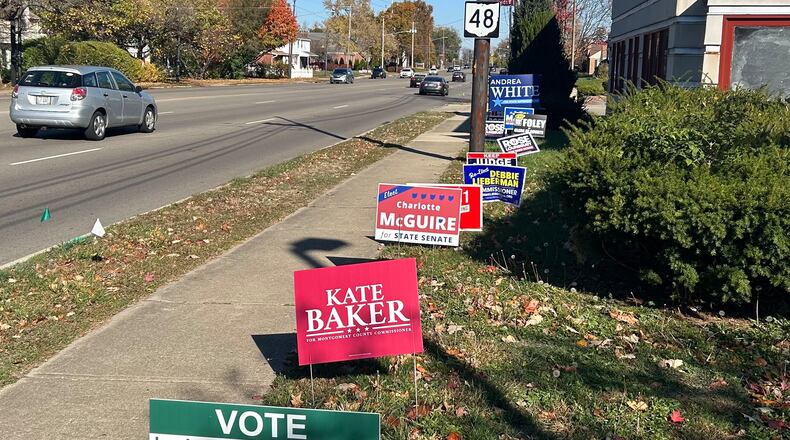It can be disappointing as voters when we don’t have choices. And competition in politics is a good thing, according to Lee Hannah, professor of political science at Wright State University.
“Competition can create discussions about important issues and can force candidates to think about the strengths of their beliefs and policies,” Hannah said. “Competition can force an incumbent to pay attention to an issue that their challenger brought up.”
The lack of candidates locally is most pronounced at the county level, and especially in the Republican-leaning counties that surround the more politically balanced Montgomery County. There are 10 races in most counties this cycle — two county commission seats, plus county sheriff, prosecutor, clerk of courts, treasurer, recorder, engineer, coroner and judge.
In Miami, Greene, Warren and Preble counties, there is exactly one contested race out of those 40 — and that’s only because the sitting Miami County Recorder resigned suddenly near the election filing date to take another job.
Credit: Bill Lackey
Credit: Bill Lackey
One county’s example
All of Greene County government’s elected offices on the 2024 ballot are uncontested races. The ballot shows only one candidate, a Republican, running for each of the offices listed above, and many of them have held those jobs for a long time.
Greene County does have Democrats running in the county’s two races for State House of Representatives, but none in the nine countywide government races.
Even if Democratic candidates want to run for these offices, the pervasive belief in Greene County is that putting a “D” next to your name spells the end of your career in government, county Democratic party chair Kim McCarthy said.
“I’ve been told by so many people over the years, that ‘That’s how it is,’ " she said.
While Donald Trump won Ohio in 2016 and 2020 by 8 percentage points each time, he won Greene County by 14 and 19 points. That trend held true in the 2022 U.S. Senate race, when JD Vance (+6 overall in Ohio) won Greene County by 19 points.
McCarthy, who ran as a Democratic candidate for Ohio State Representative in 2018, 2020 and 2021, said she learned a lot during those campaigns about what it takes to run for office.
“When I became chair of the party in ‘22, it was really top of my priorities to develop a real, solid infrastructure, to build the road that the candidates can then drive on to run their campaign,” she said.
The Greene County Democratic Party is working to galvanize more Democratic candidates in the county. Their efforts include an eight-week candidate training course, and building a network of Democratic precinct captains in the 148 precincts of Greene County.
When McCarthy started as Democratic chair, the party had about 50 precinct captains, and in two years has grown to about 80.
While no Democrats are challenging Republicans for county-level offices this year, she said the grassroots work the party is engaging in is building the foundation for future candidates.
“I would hope we want to make it so people don’t feel that they have to hide that. We want people to be proud to be Democrats in Greene County, and we’re trying to build a professional, accountable party at the grassroots level, because that’s what we believe a party should be,” McCarthy said. “And hopefully, in time, people will see that, and we’ll continue to grow and get people elected eventually.”
Competitive races bring value
Competition in a political race is good for voters and for the candidates themselves, argues Hannah, the Wright State professor.
Voters get a better look at their choices in a race with more than one candidate because the competitors are more likely to give voters information about themselves and their proposals, using ads, canvassers, mailers and other methods of reaching voters.
Competitive races also boost the broader fortunes of political parties, he said.
“If the Democrats just cede a rural county or the Republicans cede a major metropolitan area, that can lead to candidates higher on the ballot coming up short,” Hannah said. “There’s some evidence that (in 2020 Joe) Biden benefited in Georgia by having Democratic candidates running everywhere — even in noncompetitive races — because collectively they are bringing out thousands of voters.”
But people may be reluctant to become a candidate for many reasons, including the cost of campaigning, the amount of time it takes, concern about the impact on themselves or their family or because a race looks unwinnable due to the partisan makeup of the electorate where they are running.
“It is a lot of work to run for office. Candidates have to file petitions and they have to do some minimal level of organizing and canvassing,” Hannah said. “It is a big commitment and we see that most people running for office look for those offices that are winnable.”
People who are politically ambitious may choose to avoid a matchup where they are likely to lose and try to be strategic about when and where they run for office.
“One part of red and blue waves is that good and strategic candidates are waiting to enter races when the broader conditions are best,” Hannah said.
Political parties have a key role to play in making sure voters have more than one choice in a race.
“It’s important that local parties maintain and build infrastructure,” Hannah said. “It’s much easier to recruit a good candidate if you can promise they will have resources in terms of volunteers and money.”
Find key voter resources
To see how the candidates for local and state office made their case in their own words, go to DaytonDailyNews.com/voter-guide
To read news articles about election races, tax levies, voting procedure and more, go to DaytonDailyNews.com/elections




